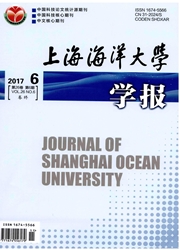

 中文摘要:
中文摘要:
根据2007年(高产年份)、2009年(低产年份)我国鱿钓船生产采集的柔鱼样本数据,对西北太平洋渔汛期间7-10月柔鱼渔获物组成及其生长率进行了比较研究。研究认为,2007年柔鱼胴长范围为200~440 mm,优势胴长为240~310 mm,占总数的75.41%;体重范围为280~2 540 g,优势体重为400~790 g,占总数的63.11%。2009年柔鱼胴长范围为160~430 mm,优势胴长为220~280 mm,占总数的66.87%;体重范围为43~9 310 g,优势体重为300~510 g,占总数的53.75%。研究发现,2007年和2009年7-10月渔获群体均存在2个群体,即大型群体(L型群)和小型群体(S型群)。2007年S型群在渔获物中出现在9月中旬,约占样本总数的32.6%;2009年S型群则提前出现在9月初,约占样本总数的16.2%。2个年份的L型群生长速率相当,2007年略微小于2009年,而2007年S型群的生长速率明显比2009年快。结合了渔场表温等环境因子对西北太平洋柔鱼渔获群体组成及其生长速度的年间差异进行了分析探讨。
 英文摘要:
英文摘要:
Based on the sample data of Ommastrephes bartramii in 2007(high-yield year) and 2009(low-yield year) collected by Chinese squid fishing fleets,the catch composition and growth rate of Ommastrephes bartramii from July to October between 2007 and 2009 were compared.The results indicated that the mantle length(ML) ranged from 200 mm to 440 mm in 2007,and the dominant ML is 240-310 mm,accounting for 75.41% of the total.The weight range from 280 g to 2 540 g,and the dominant weight is 400-790 g,accounting for 63.11%.While in 2009 the range of ML in catch is 160-430 mm,and the dominant ML is 220-280 mm,occupying 66.87% of the total.The weight range is 43-9 310 g and the dominant weight is 300-510 g,occupying 53.75% of the total.This study found that the catch groups exist in two cohorts,namely,a large group(L-type group) and small groups(S-type group) from July to October in 2007 and 2009.In 2007 the S-type group appeared in mid-September,accounting for 32.6% of the total.But in 2009 the S-type group is ahead of schedule in early September,accounting for 16.2% of the total.The growth rate of L-group in 2007 is slightly less than that in 2009,and the growth rate of S-type group in 2007 was significantly faster than that in 2009.In this study,combined with marine environmental factors such as sea surface temperature,the cause of difference on catch composition and growth rate between 2007 and 2009 are analyzed and discussed.
 同期刊论文项目
同期刊论文项目
 同项目期刊论文
同项目期刊论文
 期刊信息
期刊信息
